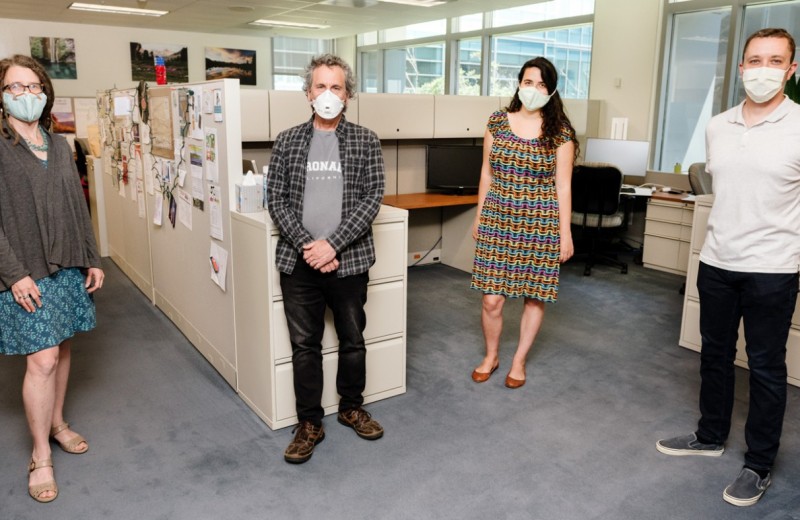
A network map of all the publications that led to the discovery and FDA approval of a new life-saving drug. All papers related to the drug are shown in green, authors of the papers are shown in purple, and institutional affiliations of the authors are shown in blue. Yellow dots are "elite performers." [Image: Alex Pico]
Scientists from the Gladstone Institutes have provided a detailed map of how basic research translates into new treatments for deadly diseases. Charting the network of discoveries that led to the development of important therapeutic drugs, the investigators revealed that, up to now, the path to a cure has required thousands of scientists and many decades. Writing in the journal Cell, the authors propose that a clearer understanding of how past successes have come about can reveal ways to accelerate the process of finding future cures.
“We started with a big question: how do scientific discoveries lay the foundation for successful development of new drugs?” says author Alexander Pico, PhD, a staff research scientist at the Gladstone Institutes. “We all have an intuitive understanding that basic research provides the starting point for new drug development, but in this paper we wanted to quantify and illuminate features of that path. Our data show that it takes contributions from a surprisingly large and complex network of individual scientists working in many locales to reach a cure.”
Using newly developed, unbiased data modeling methods, the investigators retrospectively mapped the discovery path to two drugs that have been recently approved by the FDA and could be characterized as “cures”—ipilimumab for certain forms of cancer and ivacaftor for cystic fibrosis. The researchers relied on citations from published research findings, using “bibliometrics” to work backwards to uncover the stepwise scientific advances that led to the new medications. According to the networks of cited publications, ipilimumab resulted from research conducted by 7000 scientists from 5700 institutional affiliations over the course of 100 years, while ivacaftor took 2900 scientists with 2500 different affiliations 60 years to develop.
To extract additional information from the data, the researchers developed new metrics—the Propagated In-Degree Rank (PIR) and Ratio of Basic Rankings (RBR)—to quantify the influence and selectiveness of each scientist in the network. These rankings identified “elite performers” who contributed disproportionately to the development of the drugs.
This work provides an initial step towards the development of new predictive metrics that may enhance decision-making in ways that would accelerate future research progress. Ascertaining—and then emulating—certain qualities of the elite performers may be one way to accelerate discovery and propel scientists more rapidly down the path toward cures.
What’s more, in light of waning public and governmental support for funding basic science, the researchers are hopeful that enhanced public understanding of how scientific research leads to urgently needed drugs will translate into increased and sustained Congressional support for the National Institutes of Health.
“As shown by our analysis, new treatments depend upon a broad base of scientific knowledge plus special contributions from a few exceptional scientists,” says first author R. Sanders Williams, MD, president of the Gladstone Institutes. “The ultimate goal of this work is to find ways to accelerate progress towards future cures for cruel diseases that remain unsolved: Alzheimer’s disease, Parkinson’s disease, heart failure, deadly viruses, diabetes, many cancers, and others.”
Using Next-Gen CRISPR Tool, Gladstone Scientists Create Unprecedented Molecular Map of Human Immune Response
Using Next-Gen CRISPR Tool, Gladstone Scientists Create Unprecedented Molecular Map of Human Immune Response
The new study from the Marson Lab represents a major stride for human genetics; findings will accelerate the development of new and better therapies for cancer and autoimmune diseases.
News Release Research (Publication) Autoimmune Diseases Cancer Genomic Immunology Marson Lab Basic Science CRISPR/Gene Editing Genomics Human GeneticsHerpesviruses Hedge Their Bets to Optimize Survival
Herpesviruses Hedge Their Bets to Optimize Survival
Varying levels of proteins in cytomegalovirus particles help the virus survive in different conditions.
News Release Research (Publication) Flow Cytometry Core Virology Weinberger Lab Basic Science ChaturvediNew Genomic Atlas of the Developing Human Brain
New Genomic Atlas of the Developing Human Brain
Scientists at Gladstone and UCSF created a valuable new resource for studying the origins of neurodevelopmental disease.
News Release Research (Publication) Data Science and Biotechnology Pollard Lab Basic Science Big Data Human Genetics



